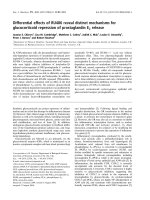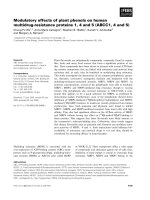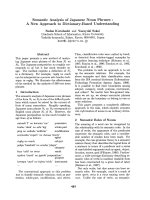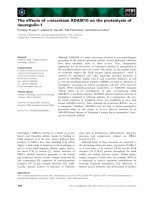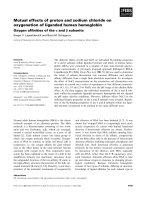Báo cáo khoa học: Anti-arthritis effects of vitamin K2 (menaquinone-4) ) a new potential therapeutic strategy for rheumatoid arthritis doc
Bạn đang xem bản rút gọn của tài liệu. Xem và tải ngay bản đầy đủ của tài liệu tại đây (652.82 KB, 7 trang )
Anti-arthritis effects of vitamin K
2
(menaquinone-4) ) a
new potential therapeutic strategy for rheumatoid arthritis
Hiroshi Okamoto, Kumi Shidara, Daisuke Hoshi and Naoyuki Kamatani
Institute of Rheumatology, Tokyo Women’s Medical University, Japan
Vitamin K is a generic term for compounds that
include phytonadione (vitamin K
1
), the menaquinone
series (vitamin K
2
) and menadione (vitamin K
3
). These
vitamin K compounds share a common chemical struc-
ture consisting of a naphthoquinone nucleus. Vita-
min K
1
has a long phytol side chain whereas
vitamin K
2
has an unsaturated side chain [1].
Vitamin K
2
acts as a cofactor for a vitamin K-
dependent carboxylase involved in the carboxylation
of coagulation factors and is an essential substrate for
blood coagulation [2]. It has been reported that osteo-
porosis and fractures frequently occurred after the
long-term use of warfarin, which inhibits the effect of
vitamin K upon coagulation [3]. Vitamin K
2
has been
shown to be a key inducer of bone mineralization in
human osteoblasts and has also been reported to inhi-
bit osteoclastogenesis of bone by induction of the
osteoclast apoptosis [4–6].
Human studies have demonstrated that vitamin K
2
is proposed to be an effective treatment for osteoporo-
sis and the prevention of fractures [7]. Menaquinone-4
(MK-4), the most common form of vitamin K
2
is
frequently used for the treatment of osteoporosis in
Japan and other Asian countries.
In addition to these biological activities, vitamin K
2
has been reported to exert an inhibitory effect on the
growth of several cell lines and tumor cells such as hepa-
toma cells [8]. Several lines of evidence indicate that
vitamin K
2
has a potent pro-apoptotic effect on leuke-
mia cell lines and primary cultured leukemia cells [9,10].
In addition, several case studies have demonstrated the
clinical benefit of vitamin K
2
in the treatment of patients
with acute myeloid leukemia and myelodysplastic syn-
drome [11–13]. Thus far, there are no studies examining
the effect of vitamin K
2
on animal models of inflamma-
tory arthritis or humans with inflammatory arthritis.
Keywords
apoptosis; collagen type II-induced arthritis;
rheumatoid arthritis; vitamin K
2
(menaquinone-4)
Correspondence
H. Okamoto, Institute of Rheumatology,
Tokyo Women’s Medical University,
10–22 Kawada-cho, Shinjuku,
Tokyo 162–0054, Japan
Fax: +81 3 5269 1726
Tel: +81 3 5269 1725
E-mail:
(Received 9 December 2006, revised
26 June 2007, accepted 12 July 2007)
doi:10.1111/j.1742-4658.2007.05987.x
Vitamin K
2
(menaquinone-4, MK-4) has been reported to induce apoptosis
in hepatocellular carcinoma, leukemia and myelodysplastic syndrome cell
lines. The effects of MK-4 on the development of arthritis have never been
addressed thus far. In the present study, we investigated the effect of MK-4
upon the proliferation of rheumatoid synovial cells and the development of
arthritis in collagen-induced arthritis. We analyzed the effect of MK-4 on
the proliferation of fibroblast-like synoviocytes using the 3-(4,5-de-
methylthiazol-2-yl)-2,5-diphenyltetrazolium bromide assay. The pro-apop-
totic effect of MK-4 upon fibroblast-like synoviocytes was investigated
with annexin V staining and DNA fragmentation and caspase 3 ⁄ 7 assays.
Moreover, we analyzed the effect of MK-4 on the development of colla-
gen-induced arthritis in female dark agouti rats. Our results indicated that
MK-4 inhibited the proliferation of fibroblast-like synoviocytes and the
development of collagen-induced arthritis in a dose-dependent manner. We
conclude that MK-4 may represent a new agent for the treatment of rheu-
matoid arthritis in the setting of combination therapy with other disease-
modifying antirheumatic drugs.
Abbreviations
CIA, collagen-induced arthritis; CII, collagen type II; FLS, fibroblast-like synoviocytes; MK-4, menaquinone-4; MTT, 3-(4,5-demethylthiazol-2-
yl)-2,5-diphenyl-tetrazolium bromide; RA, rheumatoid arthritis; TNF-a, tumor necrosis factor a.
4588 FEBS Journal 274 (2007) 4588–4594 ª 2007 The Authors Journal compilation ª 2007 FEBS
In the present study, we determined the effect of
vitamin K
2
(MK-4) on the proliferation of rheumatoid
synovial cells and the development of arthritis in the
experimental model of collagen type II-induced arthri-
tis (CIA).
Results
Effect of MK-4 on the viability of fibroblast-like
synoviocytes
It has been reported that MK-4 can induce apoptosis
in several tumor cells. It has been also reported that
rheumatoid arthritis (RA) synovial cells proliferate as
fierce as tumor cells [14]. We hypothesized that MK-4
could also reduce the viability of synovial cells and
thus be a novel treatment for RA because the marked
proliferation of synovial cells is a key pathological fea-
ture of RA. We therefore studied the biological effects
of MK-4 on the proliferation of fibroblast-like syno-
viocytes (FLS). We observed that MK-4 inhibited the
viability of FLS in a dose-dependent manner (Fig. 1).
By contrast, vitamin K
1
, which exerts no inhibitory
effects on the proliferation of tumor cell lines [10], had
no significant effect on the viability of synovial cells.
These results indicate that MK-4 exerts cytotoxic
effects on synovial cells and this may be secondary to
its side chain structure.
Induction of apoptosis of fibroblast-like
synoviocytes by MK-4
Analogous to the effects of MK-4 on tumor cells, we
hypothesized that MK-4 induces apoptotic death of
synovial cells. We therefore examined the level of
apoptosis in synovial cells by measuring annexin V
staining, DNA fragmentation and caspase activity. As
shown in Fig. 2A, most of the cells treated for 30 min
with MK-4 (10
)6
m) exhibited diffuse cytosolic annexin
V staining (mean ± SD; 45 ± 9 ⁄ 100 cells) compared
with positive (63 ± 11 ⁄ 100 cells) and negative
(12 ± 4 ⁄ 100 cells) controls. To further confirm the
pro-apoptotic effect of MK-4 on FLS, we conducted a
DNA fragmentation assay with various concentrations
of MK-4. MK-4 exhibited dose-dependent pro-apopto-
tic effects on FLS (Fig. 2B). To determine whether
MK-4 activates caspase 3 and 7 to induce apoptosis
on FLS, we conducted a caspase activity assay. MK-4
activated caspase assay in a dose-dependent manner
(Fig. 2C). By contrast, vitamin K
1
did not show any
effects on caspase activity and DNA fragmentation
(data not shown). These results indicate that the inhib-
itory effect of MK-4 on the proliferation of FLS is
secondary to the induction of apoptosis by MK-4
induction of caspase activation.
Oral administration of MK-4 ameliorates
collagen-induced arthritis
As shown in Fig. 3, MK-4 suppressed it suppressed
the initiation of clinical arthritis. compared with con-
trol rats treated with NaCl ⁄ P
i
, as demonstrated by
paw volume (Fig. 3A), arthritis score (Fig. 3B) and
bone destruction score (Fig. 3C). MK-4 treated rats
exhibited statistically significant effects in a dose-
dependent manner (P<0.01). Histological analysis of
the ankle joints of MK-4-treated rats (10 mgÆkg
)1
Æ
day
)1
and 50 mgÆkg
)1
Æday
)1
groups) at day 32 demon-
strates that MK-4 inhibits synovial proliferation and
pannus formation compared with control rats
(NaCl ⁄ P
i
) (Fig. 3D). Histology of a joint of a rat of
similar age is also shown in Fig. 3D. There was no
0
25
50
75
100
125
0
25
50
75
100
125
Cell Viability (%)
Cell Viability (%)
Vitamin K2 (MK-4)
0
*
**
*
*
**
*
52.51.250.630.3130.15
Vitamin K1
0 10 (x10
-7
M) 10 (x10
-7
M)52.51.250.630.3130.15
Fig. 1. Inhibition of synovial cell viability by vitamin K
2
(MK-4). The inhibitory effect of vitamin K
2
and vitamin K
1
was evaluated with the MTT
assay. The level of the absorbance in the MTT assay from untreated cells was taken as 100%. The data are presented as the mean ± SD.
H. Okamoto et al. Anti-arthritis effects of vitamin K
2
FEBS Journal 274 (2007) 4588–4594 ª 2007 The Authors Journal compilation ª 2007 FEBS 4589
Annexin V-FITC Propidium IodideFITC + PI
Annexin V-FITC Propidium IodideFITC + PI
Annexin V-FITC Propidium IodideFITC + PI
A
Positive control (TNF-α)
MK-4
Negative control (NaCl/P
i
)
0
0.4
0.8
1.2
MK-4
DNA fragmentation
(absorbance A
270 nm
)
0
60
Caspase 3/7 activity
(luminescence (RLU))
MK-4
B
C
*
**
*
**
0 10 (x10
-7
M)52.51.250.63
TNF-αIL-1β
40
20
*
0 10 (x10
-7
M)52.51.250.630.31
**
*
*
*
TNF-
α
Fig. 2. Induction of apoptosis in FLS by
MK-4. (A) FLS were cultured on 2-well Labo-
ratory-Tek tissue culture chamber slides.
Cells were double-stained with annexin V
and propidium iodine using the ApoAlert
Annexin V-fluorescein isothiocyanate apop-
tosis kit. In positive controls, cells were
treated with 1 ngÆmL
)1
of TNF-a. In negative
controls, cells were treated with NaCl ⁄ P
i
.
(B) DNA fragmentation induced by MK-4
was determined with the Cellular DNA Frag-
mentation ELISA kit. In positive controls,
cells were treated with 1 ngÆmL
)1
of TNF-a.
In negative controls, cells were treated with
NaCl ⁄ P
i
. Each measurement was performed
in triplicate and the results are presented as
the absorbance (A
270 nm
) compared with
positive (TNF-a) and negative (NaCl ⁄ P
i
) con-
trols. (C) Caspase activity induced by MK-4
was determined using the Caspase-Glo 3 ⁄ 7
Assay kit. In positive controls, cells were
treated with 1 ngÆmL
)1
of TNF-a or
1ngÆmL
)1
of interleukin-1b. In negative con-
trol, cells were treated with NaCl ⁄ P
i
. Each
measurement was performed in triplicate
and the results are presented as the lumi-
nescence (relative light units) compared
with positive (interleukin-1b and TNF-a) and
negative (NaCl ⁄ P
i
) controls. *P<0.05,
**P<0.01 versus control (–), by the paired
t-test.
Anti-arthritis effects of vitamin K
2
H. Okamoto et al.
4590 FEBS Journal 274 (2007) 4588–4594 ª 2007 The Authors Journal compilation ª 2007 FEBS
mortality or weight loss in MK-4-treated rats. These
data suggest that MK-4 has significant inhibitory
effects on arthritis in vivo because MK-4 suppressed
the initiation of arthritis in the CIA model.
Discussion
Synovial hyper-proliferation has reported to be caused,
at least in part, by impaired apoptosis of FLS. Defi-
cient apoptosis of FLS results from up-regulation of
anti-apoptotic molecules such as bcl-2, sumo-1 and
FLIP (Fas-associated death domain-like interleukin 1b
converting enzyme inhibitory protein) [15–18]. Defi-
cient apoptosis of FLS was reported to result from
lower expression of pro-apoptotic molecules such as
PTEN (phophatase and tensin homologue deleted from
chromosome 10) [19,20]. These data suggested that the
synovial hyperplasia in RA is the result of defective
apoptosis not due to antibody or complement media-
tiated cytotoxicity. In support of this model, various
compounds, including antirheumatic drugs, could
induce apoptosis in FLS. Indeed, methotrexate,
hydroxychloroquine, and bucillamine have all been
reported to cause apoptosis in FLS [21–24]. Therefore,
a compound that induces apoptosis in FLS could
potentially be efficacious in the treatment of RA.
Vitamin K
2
is significantly less toxic than other anti-
proliferative agents such as methotrexate. In addition,
vitamin K
2
has significant anti-osteoporotic effects.
Thus, vitamin K
2
may well open up novel future strat-
egies, including chemoprevention, for the management
of patients with RA. Vitamin K
2
is an established
treatment for patients with osteoporosis in Japan and
has been used for more than 10 years [7]. In the pres-
ent study, we have shown that vitamin K
2
inhibited
the proliferation of FLS through the induction of
apoptosis and also inhibited the development of CIA
in a dose-dependent manner. Therefore, vitamin K
2
2
2.5
3
3.5
4
4.5
0 10 20 30
Days
0
0.5
1
1.5
2
2.5
0 10 20 30
Days
0
0.5
1
1.5
2
Tarsal bone
Metatarsal bone
Calcanus
50mg/kg10mg/kgControlNormal
MK-4
Score of Bone Destruction Paw volume (ml)
Arthritis score
50mg/kg
10mg/kg
Control
Normal
Control (NaCl/P
i
)
Normal
MK-4 10mg/kg MK-4 50mg/kg
AB
CD
*
*
*
*
*
*
*
*
*
*
*
Fig. 3. Suppression of arthritis development by MK-4 in the collagen type-II induced arthritis model. (A,B) MK-4 suppressed the progression
of clinical arthritis compared with control rats treated with NaCl ⁄ P
i
, as demonstrated by paw volume and the clinical arthritis score. The data
are represented as the mean ± SD. *P < 0.05. (C) Radiological examination of bone destruction at the affected joints (calcaneus, metatarsal
and tarsal bone) in normal rats, MK-4-treated rats (10 mgÆkg
)1
Æday
)1
), MK-4 treated rats (50 mgÆkg
)1
Æday
)1
) and control rats (NaCl ⁄ P
i
)as
described in Experimental procedures. (D) Histological findings of the foot joint in normal rats, MK-4-treated rats (10 mgÆkg
)1
Æday
)1
),
MK-4-treated rats (50 mgÆkg
)1
Æday
)1
) and control rats (NaCl ⁄ P
i
).
H. Okamoto et al. Anti-arthritis effects of vitamin K
2
FEBS Journal 274 (2007) 4588–4594 ª 2007 The Authors Journal compilation ª 2007 FEBS 4591
may represent a new strategy for the treatment of RA,
presumably in the setting of combination therapy with
other disease-modifying antirheumatic drugs. Further
clinical studies are needed to evaluate the beneficial
effects of vitamin K
2
.
Experimental procedures
Synovial fibroblasts
Synovial biopsy samples were obtained from six patients
with RA and synoviocytes were maintained in separate cul-
tures. These patients had active RA as defined by the clini-
cal criteria of the American Rheumatism Association [25].
All RA patients were receiving treatment that included
methtrexate (8 mgÆweek
)1
) and nonsteroidal anti-inflamma-
tory drugs, as well as steroids (less than 5 mgÆday
)1
). How-
ever, patients treated with biological agents, such as tumor
necrosis factor a (TNF-a) blocking agents, were excluded
from the study.
All experiments were carried out using cell cultures dur-
ing the third to seventh passage. FLS were cultured at
37 °Cin5%CO
2
in DMEM (Nikken Bio Medical Labora-
tory, Kyoto, Japan) supplemented with 10% fetal bovine
serum (Bioscience International Inc., Rockville, MD,
USA).
Reagents
Vitamin K
1
(2-methyl-3-phenyl-1,4-naphthoquinone) and
vitamin K
2
(MK-4) were all supplied by EisaiCo., Ltd.
(Tokyo, Japan).
MTT assay
FLS were seeded at a density of 1 · 10
3
cells per well in 96-
well microtiter plates in 100 lL serum-free DMEM and
were treated with various concentrations of MK-4
(1.56 · 10
)7
m to 10
)6
m) for 48 h. Cell proliferation was
evaluated by measuring the number of viable cells using
the 3-(4,5-dimethylthiazol-2-yl)-2,5-diphenyl-tetrazolium
bromide (MTT) assay [26]. Experiments were performed six
times with each of the three independent cell cultures.
Annexin V staining
To examine annexin V staining, FLS were cultured on
2-well Laboratory-Tek tissue culture chamber slides. After
treatment with MK-4 (10
)6
m), cells were fixed with 4%
paraformaldehyde in NaCl ⁄ P
i
for 15 min at room tempera-
ture and examined by microscopy. Cells were double-
stained with annexin V and propidium iodine using the
ApoAlert Annexin V-fluorescein isothiocyanate apoptosis
kit (Takara Bio Inc., Shiga, Japan).
DNA fragmentation assay
Apoptosis was determined using the Cellular DNA Frag-
mentation ELISA kit (Roche Diagnostics, Mannheim, Ger-
many) to detect BrdU labeled DNA fragments. Each
measurement was performed in triplicate and the results are
presented as the absorbance (A
270 nm
) compared with posi-
tive (TNF-a) and negative (NaCl ⁄ P
i
) controls.
Caspase 3
⁄
7 assay
Apoptosis was determined using the Caspase-Glo 3 ⁄ 7 assay
kit (Promega Co., WI, USA) to detect caspase 3 ⁄ 7 activity.
Each measurement was performed in triplicate and the
results are presented as the luminescence (relative light
units) compared with positive (interleukin-1b and TNF-a)
and negative (NaCl ⁄ P
i
) controls.
CIA model in rats
Seven-week-old female dark agouti rats were obtained
from Japan SLC, Inc. (Shizuoka, Japan). 0.3% Collagen
type II (CII) solution (Koken-Cellgen, Koken, Co. Tokyo,
Japan) was used. CII emulsion was made by mixing
1 mL of 0.9% saline, 3 mL of incomplete Freund’s adju-
vant and 2 mL of 0.3% CII solution. CIA was induced
by an intradermal injection of 200 lL of CII emulsion
(collagen II 1 mgÆmL
)1
) at the base of the tail. Treatment
with MK-4 was commenced at the onset of the disease.
MK-4 and control NaCl ⁄ P
i
were orally administered once
per day at the specified dose for 32 days. Each group
was comprised with ten female dark agouti rats. MK-4
was freshly suspended in 0.5% methyl cellulose diluted in
NaCl ⁄ P
i
. In each experiment, a group of control rats
were administered 1% methyl cellulose orally. Rats were
examined for signs of CIA at days 1, 7 (onset of arthri-
tis), 14, 18, 21, 25, 28 and 32 after immunization using
the clinical parameters of paw swelling and clinical score.
The footpad volume was measured with a plethysmome-
ter TK-101 (Unicom Japan, Tokyo, Japan). A scoring
system from 0–4 was used for the clinical evaluation of
CIA as follows: 0, normal; 1, mild swelling; 2, moderate
swelling; 3, severe swelling; 4, severe and non-weight-
bearing arthritis. Each limb was graded giving a maximal
clinical score of 4 per animal [27]. For histological evalu-
ation, we performed hematoxylin and eosin staining of
tissue specimens of the ankle in five rats in both groups.
Radiological examination of bone destruction at the
affected joints (calcaneus, metatarsal and tarsal bone) of
two rats in both group was graded from 0–3 as follows:
0, normal; 1, minor signs of destruction; 2, up to 30%
destruction; 3, more than 30% destruction [27]. There
was no mortality and no body weight loss in MK-4-trea-
ted rats.
Anti-arthritis effects of vitamin K
2
H. Okamoto et al.
4592 FEBS Journal 274 (2007) 4588–4594 ª 2007 The Authors Journal compilation ª 2007 FEBS
Statistical analysis
The Mann–Whitney U-test was used to compare nonpara-
metric data for statistical significance. This test was used to
evaluate the histological examination of ankle joints, paw
volume and the clinical arthritis score.
Acknowledgements
The expert technical help of Yukiko Katagiri is grate-
fully acknowledged.
References
1 Suttie JW (1993) Synthesis of vitamin K-dependent pro-
teins. FASEB J 7, 445–452.
2 Liu Y, Nelson AN & Lipsky JJ (1996) Vitamin K-
dependent carboxylase: mRNA distribution and effects
of vitamin K-deficiency and warfarin treatment.
Biochem Biophys Res Commun 224, 549–554.
3 Simon RR, Beaudin SM, Johnston M, Walton KJ &
Shaughnessy SG (2002) Long-term treatment with
sodium warfarin results in decreased femoral bone
strength and cancellous bone volume in rats. Thromb
Res 105, 353–358.
4 Yamaguchi M, Taguchi H, Gao YH, Igarashi A & Tsu-
kamoto Y (1999) Effect of vitamin K2 (menaquinone-7)
in fermented soybean (natto) on bone loss in ovariecto-
mized rats. J Bone Miner Metab 17, 23–29.
5 Akiyama Y, Hara K, Tajima T, Murota S & Morita I
(1994) Effect of vitamin K2 (menatetrenone) on osteo-
clast-like cell formation in mouse bone marrow cultures.
Eur J Pharmacol 263, 181–185.
6 Kameda T, Miyazawa K, Mori Y, Yuasa T, Shiokawa
M, Nakamaru Y, Mano H, Hakeda Y, Kameda A &
Kumegawa M (1996) Vitamin K2 inhibits osteoclastic
bone resorption by inducing osteoclast apoptosis.
Biochem Biophys Res Commun 220, 515–519.
7 Shiraki M, Shiraki Y, Aoki C & Miura M (2000) Vita-
min K2 (menatetrenone) effectively prevents fractures
and sustains lumbar bone mineral density in osteoporo-
sis. J Bone Miner Res 15, 515–521.
8 Wang Z, Wang M, Finn F & Carr BI (1995) The
growth inhibitory effect of vitamins K and their actions
on gene expression. Hepatology 2, 875–882.
9 Yaguchi M, Miyazawa K, Katagiri T, Nishimaki J, Kizaki
M, Tohyama K & Toyama K (1997) Vitamin K2 and its
derivatives induce apoptosis in leukemia cells and enhance
the effect of all-trans retinoic acid. Leukemia 11, 779–787.
10 Yaguchi M, Miyazawa M, Otawa M, Katagiri T, Nishi-
maki J, Uchida Y, Iwase O, Gotoh A, Kawanishi Y &
Toyama K (1998) Vitamin K2 selectively induces apop-
tosis of blastic cells in myelodysplastic syndrome: flow
cytometric detection of apoptotic cells using APO2.7
monoclonal antibody. Leukemia 12, 1392–1397.
11 Miyazawa K, Nishimaki J, Ohyashiki K, Enomoto S,
Kuriya S, Fukuda R, Hotta T, Teramura M, Mizoguchi
H, Uchiyama T et al. (2000) Vitamin K2 therapy for
myelodysplastic syndrome (MDS) and post-MDS acute
myeloid leukemia: information through a questionnaire
survey of multi-center pilot studies in Japan. Leukemia
14, 1156–1157.
12 Takami A, Nakao S, Ontachi Y, Yamauchi H & Mat-
suda T (1998) Successful therapy of myelodysplastic
syndrome with menatetrenone, a vitamin K2 analog.
Int J Hematol 69, 24–26.
13 Fujita H, Tomiyama J & Tanaka T (1998) Vitamin K2
combined with all-trans retinoic acid induced complete
remission of relapsing acute promyelocytic leukemia.
Br J Haematol 103, 584–585.
14 Firestein GS (2003) Evolving concepts of rheumatoid
arthritis. Nature 423, 356–361.
15 Franz JK, Pap T, Hummel KM, Nawrath M, Aicher
WK, Shigeyama Y, Muller-Ladner U, Gay RE & Gay S
(2000) Expression of sentrin, a novel anti-apoptotic mole-
cule, at sites of synovial invasion in rheumatoid arthritis.
Arthritis Rheum 43, 599–607.
16 Perlman H, Liu H, Georganas C, Koch AE, Shamiyeh E,
Haines GK & 3rd & Pope RM (2001) Differential expres-
sion pattern of the anti-apoptotic proteins, Bcl-2 and
FLIP, in experimental arthritis. Arthritis Rheum 44,
2899–2908.
17 Schedel J, Gay RE, Kuenzler P, Seemayer C, Simmen B,
Michel BA & Gay S (2002) FLICE-inhibitory protein
expression in synovial fibroblasts and at sites of cartilage
and bone erosion in rheumatoid arthritis. Arthritis
Rheum 46, 1512–1518.
18 Catrina AI, Ulfgren AK, Lindblad S, Grondal L &
Klareskog L (2002) Low levels of apoptosis and high
FLIP expression in early rheumatoid arthritis synovium.
Ann Rheum Dis 61, 934–936.
19 Goberdhan DC & Wilson C (2003) PTEN: tumour sup-
pressor, multifunctional growth regulator and more.
Hum Mol Genet 12, R239–R248.
20 Pap T, Franz JK, Hummel KM, Jeisy E, Gay R & Gay S
(2000) Activation of synovial fibroblasts in rheumatoid
arthritis: lack of expression of the tumour suppressor
PTEN at sites of invasive growth and destruction.
Arthritis Res 2, 59–64.
21 Kim WU, Yoo SA, Min SY, Park SH, Koh HS, Song
SW & Cho CS (2006) Hydroxychloroquine potentiates
Fas-mediated apoptosis of rheumatoid synoviocytes.
Clin Exp Immunol 144, 503–511.
22 Wunder A, Schellenberger E, Mahmood U, Bogdanov
A Jr, Muller-Ladner U, Weissleder R & Josephson L
(2005) Methotrexate-induced accumulation of fluores-
cent annexin V in collagen-induced arthritis. Mol
Imaging 4, 1–6.
23 Nakazawa F, Matsuno H, Yudoh K, Katayama R,
Sawai T, Uzuki M & Kimura T (2001) Methotrexate
H. Okamoto et al. Anti-arthritis effects of vitamin K
2
FEBS Journal 274 (2007) 4588–4594 ª 2007 The Authors Journal compilation ª 2007 FEBS 4593
inhibits rheumatoid synovitis by inducing apoptosis.
J Rheumatol 28, 1800–1808.
24 Sawada T, Hashimoto S, Furukawa H, Tohma S, Inoue T
& Ito K (1997) Generation of reactive oxygen species is
required for bucillamine, a novel anti-rheumatic drug, to
induce apoptosis in concert with copper. Immunopharma-
cology 35, 195–202.
25 Arnett FC, Edworthy SM, Bloch DA, McShane DJ, Fries
JF, Cooper NS, Healey LA, Kaplan SR, Liang MH,
Luthra HS et al. (1987) The American Rheumatism
Association 1987 revised criteria for the classification of
rheumatoid arthritis. Arthritis Rheum 31, 315–324.
26 Okamoto H, Cujec TP, Okamoto M, Peterlin BM, Baba
M & Okamoto T (2000) Inhibition of the RNA-depen-
dent transactivation and replication of human immuno-
deficiency virus type 1 by a fluoroquinoline derivative
K-37. Virology 272, 402–408.
27 Larsson E, Harris HE, Palmblad K, Mansson B, Saxne
T & Klareskog L (2005) CNI-1493, an inhibitor of pro-
inflammatory cytokines, retards cartilage destruction in
rats with collagen induced arthritis. Ann Rheum Dis 64,
494–496.
Anti-arthritis effects of vitamin K
2
H. Okamoto et al.
4594 FEBS Journal 274 (2007) 4588–4594 ª 2007 The Authors Journal compilation ª 2007 FEBS





